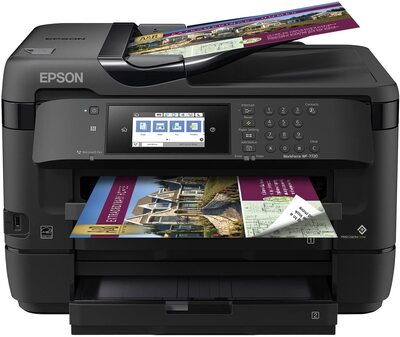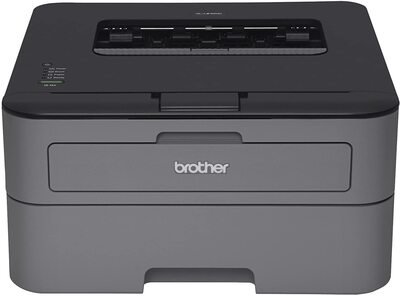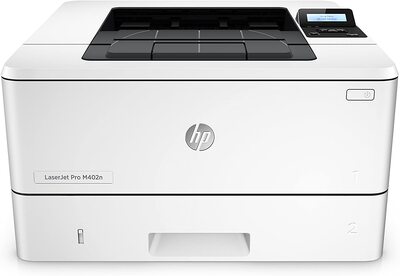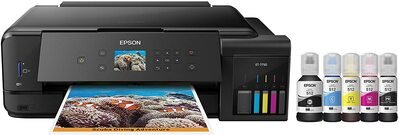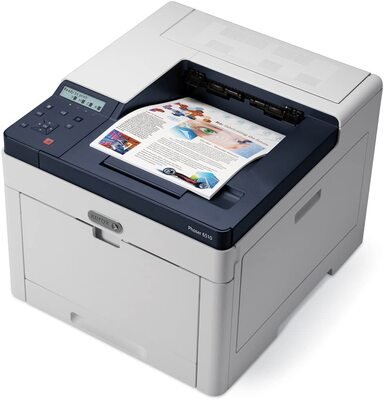You have the ability to produce postcards, greeting cards, business cards, or other fancy cards from the comfort of your home thanks to a printer made with cardstock in mind. You can use a cardstock printer to produce all of these cards, but you need to find a choice that can handle the paper you want to use while also being easy to control.
Contents
Top 3 Printer For Cardstock in 2023
Product | |||
Brand | Canon | Epson | Brother |
Dimensions | 23 x 12.3 x 6.3 inches | 32.2 x 22.3 x 13.4 inches | 14.2 x 14 x 7.2 inches |
Item Weight | 17.9 pounds | 40.8 pounds | 15 pounds |
Special Features | Five Colors of Ink For More Detail | A Green Choice | Ideal For Black and White Printing |
The 10 Best Printer For Cardstock Reviews
1. Canon Pixma iX6820 – Five Colors of Ink For More Detail
Your first choice for a great printer is this model from Canon. The Pixma iX6820 is an inkjet model from one of the top companies in the world of photography and printing.
The 9600×2400 maximum resolution setting ensures you can produce more detailed features in your papers. The five-color ink system also works with four dye-based inks to produce more detailed photos. The fifth ink is a pigment-based black ink material that produces detailed text in the works you want to create. The inks can produce 1-picoliter droplets to create the most detailed photos around.
The printer works with image analysis features to provide appropriate settings for how well a printout may be produced. You can use the analysis features on this printer to help you create a better image at any time. The My Image Garden feature includes facial recognition and spatial analysis points to help adjust the printer settings based on what the unit feels is best for your next task.
The Wi-Fi support is built within the printer to keep the printer working well. The unit can link to any computer that needs support. You can also get the printer to work with a virtual queue that identifies which particular printing tasks need to be done first.
Pros
- Offers Google Cloud Print support
- You can work with many setting templates based on the media you’re using
- Offers room for several pounds of paper at a time
Cons
- The ink cartridges are tough to load up and remove
- Requires regular tray adjustments for the unit to work well
2. Epson Workforce WF-7720 – A Green Choice
You won’t have to worry about using lots of power when getting the Epson Workforce WF-7720 running for your print-on cardstock needs. The Workforce printer uses about 80 percent less power than comparable models.
The printer can work with Wi-Fi, Ethernet, and NFC connections. The unit doesn’t need lots of data or power for it to start working for your use. You also have the option to use a low-power USB connection to directly link the Workforce printer to a computer.
The automatic two-sided copy, scan, and fax feature also ensure you can take care of all these tasks from one spot without having to use several machines at a time. The 35-page automatic document feeder makes the unit easy to support as well.
The 500-sheet tray works well, but a rear tray is also included for cardstock. The 125-sheet output tray ensures you can get your cardstock collected in a single spot to ensure the printing on heavy cardstock tasks works effectively.
Pros
- You can use the Epson printing app to control the printer on the go
- 4.3-inch control panel included on the printer body
- Can handle 10 images per second in color or 18 in black and white
Cons
- Does not include a USB cable needed for some connections
- The two separate trays for paper can be easy to mix up
3. Brother HL-L2300D – Ideal For Black and White Printing
Not all cardstock tasks require you to print in color. You can use the Brother HL-L2300D printer if you want something that offers a useful body for black and white needs.
The HL-L2300D is a laser printer that works with a two-sided printing setup. The toner that you utilize can work on both sides with a resolution of up to 2400×600 dpi.
The 250-sheet tray for paper makes it easy for you to get your printing tasks running, although this would require you to look at the thickness of the cardstock you wish to utilize. The manual feed slot and rear paper exit features will provide you with the controls you demand and for ensuring the controls work well.
The fast speed that the Brother printer can handle is a huge plus to notice. The printer works with a speed of about 27 pages per minute or ppm.
Pros
- Works with a fast USB 2.0 connection
- The automatic duplex feature will work well for saving papers
- The compact body is easy to secure on any counter or other compact spots
Cons
- Does not work with any wireless printing features
- You can only get the printer running on one computer at a time
- Does not work with a direct control screen on its body
4. HP Laserjet Pro M402n – Works With Ethernet Quality
The Ethernet connection standard is popular for offering a secure and fast link for many devices to work with. The HP Laserjet Pro M402n monochrome printer offers support for cardstock materials while also using an Ethernet connection for functionality.
The M402n offers speeds of up to 40 ppm for black and white images. The unit can work with a fast connection with enough room for many cardstock papers. You can get at least 200 cardstock paper materials loaded into the printer. The adjustable paper tray makes it easy for you to control the unit when you’re working with business cards or other one-sided formal paper options.
The two-line display on the side lets you set up the control features on the printer. You don’t need to worry about any bothersome controls when trying to make the printer work right.
Pros
- Works with body standard and high-yield toner cartridges
- The printer shuts off automatically when idle for a while
- You can link a smartphone or tablet document directly to the printer
Cons
- You cannot use both Ethernet and USB links at the same time
- No print from USB drive feature
- No automatic document feeder system
5. Xerox VersaLink C400/DN – Flexible Laser Functionality
You can use the Xerox VersaLink C400/DN when you’re looking for a quality laser printer that can handle cardstock with both color and black and white arrangements in mind. The printer uses a secure printing system that ensures your printing tasks will be handled carefully.
The design of the Xerox VersaLink printer provides a connectivity setup that is easy to manage. The unit will detect devices that are compatible with the printer and will ensure all data is handled in the printing process is secured well. The intrusion prevention feature will ensure the laser functionality will make the most out of the work you’re planning.
The Xerox printer offers a five-inch color control panel to help you with controlling the quality of the printouts you’re working with. The panel is very easy to use for when you need to get different tasks planned out accordingly. The fast speed of the printer is also a plus as this model can handle 30 ppm in black and white.
Pros
- Offers a large paper capacity with support for many cardstock units
- The on-board control panel offers various control means
- The app-based program makes it easy for you to get a document linked
Cons
- The physical body of the printer is a little too large
- Takes a bit to start up
6. Canon TS9120 – Connects In Many Ways
The design of the Canon TS9120 gives you the power to set up your printing tasks in many forms. You can use one of many connectivity options to make the most out of your Canon printing experience.
The unit operates with a wireless LAN and Wi-Fi connection setup. You can use this to link to many computers at a time while using an organized queue that ensures the printer will not be forced into more stress than necessary when taking care of many printing chores.
The Bluetooth support helps with wireless links, but the assorted other programs that the printer uses add a nice touch. You can use the Canon Print app on a mobile device to control the functionality of the printer. Google Cloud Print and PictBridge support are also included for allowing the printer to stay active.
The adjustable printing tray works for many types of cardstock materials. These include a separate setting and layout for business cards. Individual setups for photos are available with 4×6, 5×7, and 5×5 adjustment options available.
Pros
- The control screen on the printer offers a simple plan for adjusting its settings
- Can work with disc-based materials as well
- Front and rear cardstock paper support included
Cons
- Takes a bit to read data on the built-in memory card reader
- The output tray requires extra attachments to extend out further
7. Epson Expression Premium ET-7750 – Works Without Cartridges
While many cardstock printers work with ink or toner cartridges, the Epson Expression Premium ET-7750 is an exception. The printer does not require any physical cartridges for its use. You can get the printer ready with a simple layout that includes ports for ink on the end of the printer body.
The design works in that you will add the ink manually into the printer. The levels on the side let you know how much ink is left. This includes the four-color inks you can use and the black pigment material. The inks can work for 5760×1440 images and can handle photos up to 11×17 in size. The best part of working with these inks is to ensure you can get the best materials applied in moments.
The USB and memory card slots provide you with the option to print things without access to a computer. The display screen on the printer identifies the things that you wish to utilize. You can also use Wi-Fi and Ethernet controls for your use when getting access to things of value.
Pros
- The ports for ink are easy to fill
- Works with copy, scan, and photo options
- The Ethernet connection is very easy to secure and prepare
Cons
- The auto-stop ink bottles included don’t always stop as needed
- The printer has too big of a footprint
8. Xerox Phaser 6510/DN – Offers Pantone Support
The Xerox Phaser 6510/DN is unique among cardstock printers for working with Pantone color swap matching technology. Pantone, a group that focuses heavily on color support and design, offers its unique swap matching system to help the printer find the right settings based on the colors being printed. The results that you’ll get out of your cardstock prints will meet your demands thanks to the intense focus on accuracy that the Pantone system works with.
The Wi-Fi-ready printer can handle speeds of 30 ppm and can run with a monthly cycle of 30,000 pages per month. The printer also starts up in a few moments after you turn the power on, thus giving you the extra control you need for making the print run right away and be more useful.
The continuous printing feature provides a helpful design that isn’t hard to manage. The unit provides a simple design that keeps the cardstock print running fast without obstructions.
Pros
- Supports a variety of cardstock paper materials
- Automatic duplexing ensures both sides are printed right
- Works with black and white and color together for better accuracy
Cons
- The unit is extremely heavy at more than 60 pounds
- The paper loading feature is hard to work with
- The control panel doesn’t look too distinct
9. Brother HL-L6200DWT – Duplex Printing Adds Simplicity
The duplex printing support provided by the Brother HL-L6200DWT printer gives you extra help for managing printing functions in moments. The printer uses a design where two paper trays are utilized to handle more printing functions. The trays can work with two separate cardstock sizes. The printer can also sense when the trays are adjusted based on the cardstock size, thus automatically triggering one tray based on the printing job data being sent out.
The fast support offered by the printer will offer a useful setup that isn’t hard to follow. The support includes help for managing many print speeds based on the complexity of the task. You can get this to work at up to 48 ppm at a time.
You can also add a USB link to the printer as needed. The USB speed on this model is very fast.
Pros
- Immense paper capacity
- Works with USB and Ethernet links alongside a Wi-Fi setup
- The printer responds quickly to new requests for printing tasks
Cons
- Takes a bit for the Wi-Fi connection to the startup
- The single-bar control panel is tough to use
10. Canon Pixma PRO-10 – Analyzes Colors Well
Your last option for a useful printer is this model from Canon in its Pixma line. The printer offers a color analysis system called the Optimum Image Generating setup. The potential ink combinations that are needed for producing certain colors are analyzed before the printing task. The effort ensures the materials being printed will be easy to follow and handle.
The Chroma Optimizer feature also identifies how high the ink should be over your cardstock. The setup will analyze the ink that needs to be applied and regulates how well the ink is reflected off of the surface. The quality of the paper is subject to review to confirm the quality of what is used here.
The high-speed USB setup also helps you to plug the printer into a computer for a fast link. The added Ethernet and Wi-Fi connections are huge pluses to note.
You can also connect a camera phone, camcorder, or digital camera to the printer through the PictBridge connection setup. No computer is needed for making this setup work.
Pros
- Handles intense resolution settings at up to 4800 dpi
- Borderless printing provides a more accurate picture
- Works with many inks
Cons
- It may be tough to keep every ink in the printer organized
- Takes a bit to start up
A Buyer’s Guide For Finding the Best Printer For Cardstock
What Is Card Stock?
Card stock, or cardstock as it is also called, is a type of paper stock that is thicker than what you may be used to. The surface is still flexible enough when compared with other paperboard materials.
The stock may be measured in points based on how thick printer paper it is. Card stock can be 10 points or 0.01 inches thick, for instance. 1 point of thickness refers to 0.001 inches.
Why Would You Use Cardstock Material?
Card stock is used mainly for handling business cards, postcards, greeting cards, and other special types of paper materials. These include ones that need to be more refined and firmer than the basic paper you’d use in an average printer.
What Sizes Work For Cardstock?
You’ll have to ensure your printer can handle many cardstock sizes. Printers can work with many types of cardstock shapes, including ones sized like traditional greeting cards or business cards. You will have to review the ISO sizing standards that the printer can handle.
Glossy Support Points
A printer for cardstock use should also have the ability to handle glossy materials. A glossy card stock material may include a coated finish on one side. A stock material with one side of the coating is listed as C1S, while a card with two sides of coating is a C2S unit.
How Much Paper Can You Handle?
Every printer can handle a certain amount of paper at a time. Some printers can work with heavy cardstock up to 50 pounds of paper in their tray at a time. Considering how extensive some printing on cardstock jobs might be, you will have to notice how well your printer can work with all that paper and how the effort you put in is managed accordingly.
What Is the Functionality of the Printer?
Look at how well the printer in question for your use works before finding something of value. You can find some printers that work with inkjet materials. These can do well depending on the quality of the ink that you are using.
A laser printer that uses toner may also help. Such a printer will ensure the toner for your paper stock is embedded into the paper well enough and that the materials you use will appear attractive. You have to notice this well when getting something that provides a better appearance for your use.
Connectivity Points
Don’t forget to look at how well you can get your printer to connect to a computer. Many of today’s printers are designed to work with USB connections, although some models can link to Wi-Fi networks for wireless printing functionality. You can also use some cloud-ready printers that can store information on printing jobs online. The added storage ensures you’ll get your printing task ready for use as soon as possible.
Some printers also come with ports for USB drives and memory cards. You could print a compatible file off of one of these portable drives without having to link to a computer to make it work. You should ensure the control panel included provides a simple layout for handling content.
Resolution Quality
Be aware of the resolution quality of the printer you wish to utilize. The resolution that you will utilize can work with as many dpi or dots per inch as possible. The dpi is a measurement of how dense the printout on something may be. You can prepare a printout that is as detailed as you want it to be.
The resolution is typically reflective of the color printouts you can get out of your printer. You may have a lower resolution for black and white ink. This is due to the number of ink nozzles for black ink being much lower than what you’d get out of a color setup.
The IPS is a part of the quality that should be noticed as well. The IPS refers to the images per second that a printer can work with. This is not reflective of the overall speed of the printer, but rather of how well the printer can handle detailed images that it might need to work with. Naturally, the speed for black and white photos will be faster than that of the speed for color images.
Editor’s Pick
The Canon Pixma iX6820 printer offers a useful design for providing a better printout on many types of cardstock. The flexibility of the printer to handle many forms of cardstock and various connections is a plus. The resolution support on the Pixma printer is also helpful for giving your print jobs the control and design functions they deserve.
A Final Word
The assortment of printers that you can check out for your needs is all deserving to notice. You should look at how well these printers can work for you, but the best option for you to try out when getting something ready for your printing needs is the Canon Pixma iX6820.

